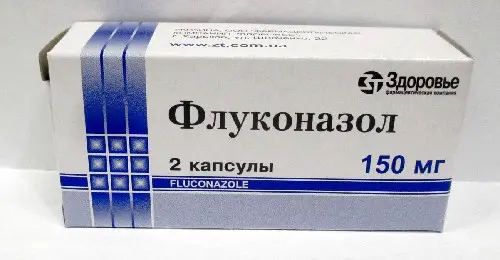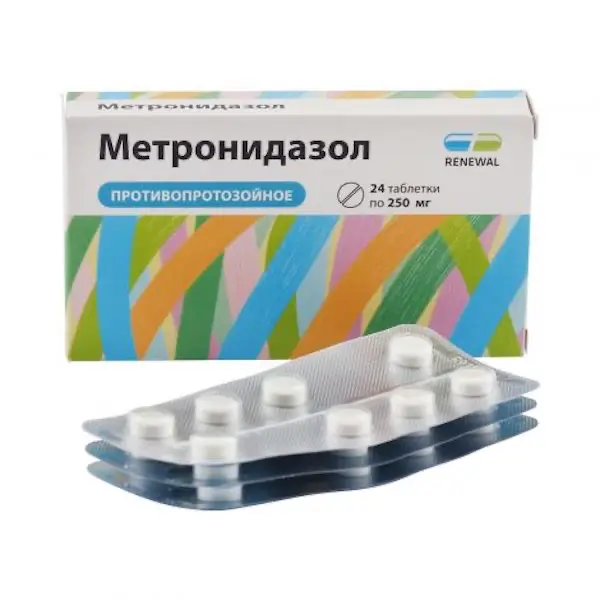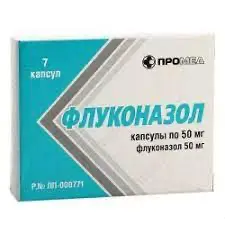Description
Fluconazole 150 mg Pharmacodynamics
Fluconazole 150 mg, a triazole antifungal agent, is a potent selective inhibitor of sterol synthesis in the fungal cell.
Fluconazole showed activity in vitro and in clinical infections against most of the following microorganisms: Candida albicans, Candida glabrata (many strains are moderately sensitive), Candida parapsilosis, Candida tropicalis, Cryptococcus neoformans.
In vitro activity of fluconazole against the following microorganisms has been shown, but its clinical significance is unknown: Candida dubliniensis, Candida guilliermondii, Candida kefyr, Candida lusitaniae.
When administered orally, fluconazole shows activity in various models of fungal infections in animals. The drug has demonstrated activity in opportunistic mycoses, including those caused by Candida spp. (including generalized candidiasis in animals with suppressed immunity), Cryptococcus neoformans (including intracranial infections), Microsporum spp. and Trychophyton spp. Fluconazole activity was also found in models of endemic mycoses in animals, including infections caused by Blastomyces dermatitides, Coccidioides immitis (including intracranial infections) and Histoplasma capsulatum in animals with normal and suppressed immunity.
Fluconazole has high specificity against cytochrome P450-dependent fungal enzymes. Fluconazole therapy at a dose of 50 mg/day for up to 28 days has no effect on plasma testosterone concentrations in men or steroid concentrations in women of childbearing age. Fluconazole at a dose of 200 to 400 mg/day has no clinically significant effect on endogenous steroid levels and their response to adrenocorticotropic hormone (ACTH) stimulation in healthy male volunteers.
Mechanisms of development of resistance to fluconazole
Resistance to fluconazole can develop in the following cases: a qualitative or quantitative change in the enzyme that targets fluconazole (lanosterol 14-alpha-demethylase), reduced access to the fluconazole target, or a combination of these mechanisms.
Point mutations in the ERG11 gene, which encodes the target enzyme, result in target alteration and decreased affinity to azoles. Increased expression of the ERG11 gene leads to the production of high concentrations of the target enzyme, which creates a need for increased fluconazole concentrations in the intracellular fluid to inhibit all enzyme molecules in the cell.
The second significant mechanism of resistance is the active excretion of fluconazole from the intracellular space through the activation of two types of transporters involved in the active excretion (efflux) of the drugs from the fungal cell. These transporters include the main mediator encoded by the MDR (multiple drug resistance) genes and the superfamily of ATP-binding cassette transporters encoded by the CDR (resistance genes of Candida fungi to azole antimycotics) genes.
Hyperexpression of the MDR gene leads to resistance to fluconazole, while CDR gene hyperexpression can lead to resistance to various azoles. Resistance to Candida glabrata is usually mediated by CDR gene overexpression, which leads to resistance to many azoles. For those strains in which the minimum inhibitory concentration (MIC) is defined as intermediate (16-32 µg/ml), maximum doses of fluconazole are recommended.
Candida krusei should be considered resistant to fluconazole. The mechanism of resistance is associated with decreased sensitivity of the target enzyme to the inhibitory effects of fluconazole.
- Oral administration. The capsules are swallowed whole.
- Therapy may be started before the results of culture and other laboratory tests are available. However, antifungal therapy should be modified accordingly when the results of these tests become known.
- The daily dose of fluconazole depends on the nature and severity of the fungal infection. In infections requiring repeated dosing, treatment should be continued until clinical or laboratory signs of active fungal infection disappear. Patients with AIDS and cryptococcal meningitis or recurrent oropharyngeal candidiasis usually need maintenance therapy to prevent recurrent infection.
- Use in adults
- In cryptococcal meningitis and cryptococcal infections of other localizations, the drug is usually used in a dose of 400 mg on the first day and then continues treatment in a dose of 200-400 mg once a day. The duration of treatment of cryptococcal infections depends on the presence of clinical and mycological effect; in cryptococcal meningitis, treatment usually continues for at least 6-8 weeks. In cases of treatment of life-threatening infections, the daily dose may be increased to 800 mg. To prevent relapse of cryptococcal meningitis in patients at high risk of relapse, after completion of the full course of primary treatment, fluconazole therapy at a dose of 200 mg/day may be continued for an indefinite period of time.
- In coccidioidomycosis, a dose of 200-400 mg/day may be required. For some infections, especially with brain lesions, a dose of 800 mg/day may be considered. Duration of therapy is determined individually and may last up to 2 years; it is 11-24 months for coccidioidomycosis, 2-17 months for paracoccidioidomycosis, 1-16 months for sporotrichosis and 3-17 months for histoplasmosis.
- In candidemia, disseminated candidiasis and other invasive candidiasis infections, the saturation dose is 800 mg on the first day, followed by a dose of 400 mg/day. The duration of therapy depends on clinical efficacy. The general recommendation for the duration of candidemia treatment is 2 weeks after the first negative blood culture result and disappearance of signs and symptoms of candidemia.
- Treatment of mucous candidiasis
- In oropharyngeal candidiasis, the saturation dose: 200-400 mg on the first day, subsequent dose: 100-200 mg once a day for 7-21 days. If necessary, in patients with pronounced immune function suppression, treatment can be continued for a longer time.
- In candiduria the effective dose is usually 200-400 mg/day with a treatment duration of 7-21 days. In patients with severe immune system dysfunction, longer periods of therapy may be used.
- In chronic cutaneous-mucosal candidiasis, 50-100 mg/day is used for up to 28 days of treatment. Longer periods of therapy may be used depending on the severity of treatment of the infection or concomitant immune system dysfunction and infection.
- For esophageal candidiasis, a saturation dose of 200-400 mg on the first day, followed by a dose of 100-200 mg daily. The course of treatment is 14-30 days (until remission of oesophageal candidiasis is achieved). If necessary, in patients with marked suppression of immune function, treatment may be continued for a longer period.
- For prevention of oropharyngeal candidiasis recurrence in HIV-infected patients with a high risk of relapse, fluconazole is used 100-200 mg per day or 200 mg 3 times a week for an indefinite period in chronically immunocompromised patients.
- To prevent recurrence of esophageal candidiasis in HIV-infected patients at high risk of recurrence, fluconazole is used 100-200 mg daily or 200 mg 3 times weekly for an indefinite period of time in chronically immunocompromised patients.
- In chronic atrophic oral candidiasis associated with the wearing of dentures, the drug is usually used in a dose of 50 mg once daily for 14 days in combination with local antiseptics for denture treatment.
- In acute vaginal candidiasis, candidal balanitis, fluconazole is used once orally in a dose of 150 mg. To reduce the frequency of vaginal candidiasis recurrence, the drug may be used in a dose of 150 mg every three days – 3 doses in total (on day 1, 4, and 7), then a maintenance dose of 150 mg once a week. The maintenance dose can be used up to 6 months.
- In onychomycosis the recommended dose is 150 mg once a week. Treatment should be continued until the infected nail is replaced (uninfected nail grows back). It usually takes 3-6 months and 6-12 months for nails on fingers and feet to re-grow, respectively. However, the growth rate can vary widely from person to person and also depending on age. After successful treatment of long-standing chronic infections, sometimes there is a change in the shape of the nails.
- Treatment of dermatomycoses
In skin infections, including foot dermatophytosis, trunk dermatophytosis, inguinal dermatophytosis, and candida infections, the recommended dose is 150 mg once weekly or 50 mg once daily. The duration of therapy is usually 2-4 weeks, with mycoses of the feet may require longer therapy of up to 6 weeks. - In variegated shingles, the recommended dose is 300-400 mg once a week for 1-3 weeks. An alternative regimen is to use 50 mg once a day for 2 to 3 weeks.
For prevention of candidiasis in patients with malignant tumors, the recommended dose of fluconazole is 200-400 mg once a day, depending on the degree of risk of fungal infection. For patients with a high risk of generalized infection, such as those with severe or prolonged neutropenia, the recommended dose is 400 mg once daily. Fluconazole is used several days before the expected development of neutropenia, and after increasing neutrophil counts over 1000 per mm3, the treatment is continued for 7 days. - Use in children
As with similar infections in adults, the duration of treatment depends on the clinical and mycological effect. For children, the daily dose of the drug should not exceed that for adults. Fluconazole is used daily once a day.
In mucosal candidiasis the recommended dose of fluconazole is 3 mg/kg/day. On the first day, in order to achieve equilibrium concentration more quickly, a shock dose of 6 mg/kg may be used. - For treatment of invasive candidiasis and cryptococcal meningitis, the recommended dose is 6-12 mg/kg/day depending on the severity of the disease.
For suppression of relapse of cryptococcal meningitis in children with AIDS, the recommended dose of fluconazole is 6 mg/kg/day. - For prevention of fungal infections in immunocompromised children whose risk of infection is associated with neutropenia developed as a result of cytotoxic chemotherapy or radiation therapy, the drug is used at 3-12 mg/kg/day, depending on the severity and duration of maintenance of induced neutropenia (see dose for adults; for children with renal impairment, see dose for patients with renal impairment).
- If it is impossible to use fluconazole capsules in children, the possibility of substitution with other dosage forms of the drug (powder for oral suspension or solution for intravenous injection) in equivalent doses should be considered.
- Administration in elderly persons
In the absence of signs of renal failure, fluconazole is used in the usual dose. In patients with renal insufficiency (creatinine clearance <50 ml/min) the drug dose is adjusted as described below. - Administration in patients with renal insufficiency
There is no need to change the dose if administered once. In patients (including children) with impaired renal function, a shock dose of 50 mg to 400 mg should be administered initially, after which the daily dose (depending on the indication) is adjusted according to the following table: - Creatinine clearance (mL/min) Percent of recommended dose
>50 100%
? 50 (without dialysis) 50%
Regular dialysis 100% after each dialysis - Patients on regular dialysis should receive 100% of the recommended dose after each dialysis session. Patients should receive a reduced dose (depending on creatinine clearance) on the day they are not on dialysis.
In children with impaired renal function, the daily dose of the drug should be reduced (in the same proportional relationship as in adults) according to the severity of renal failure.





